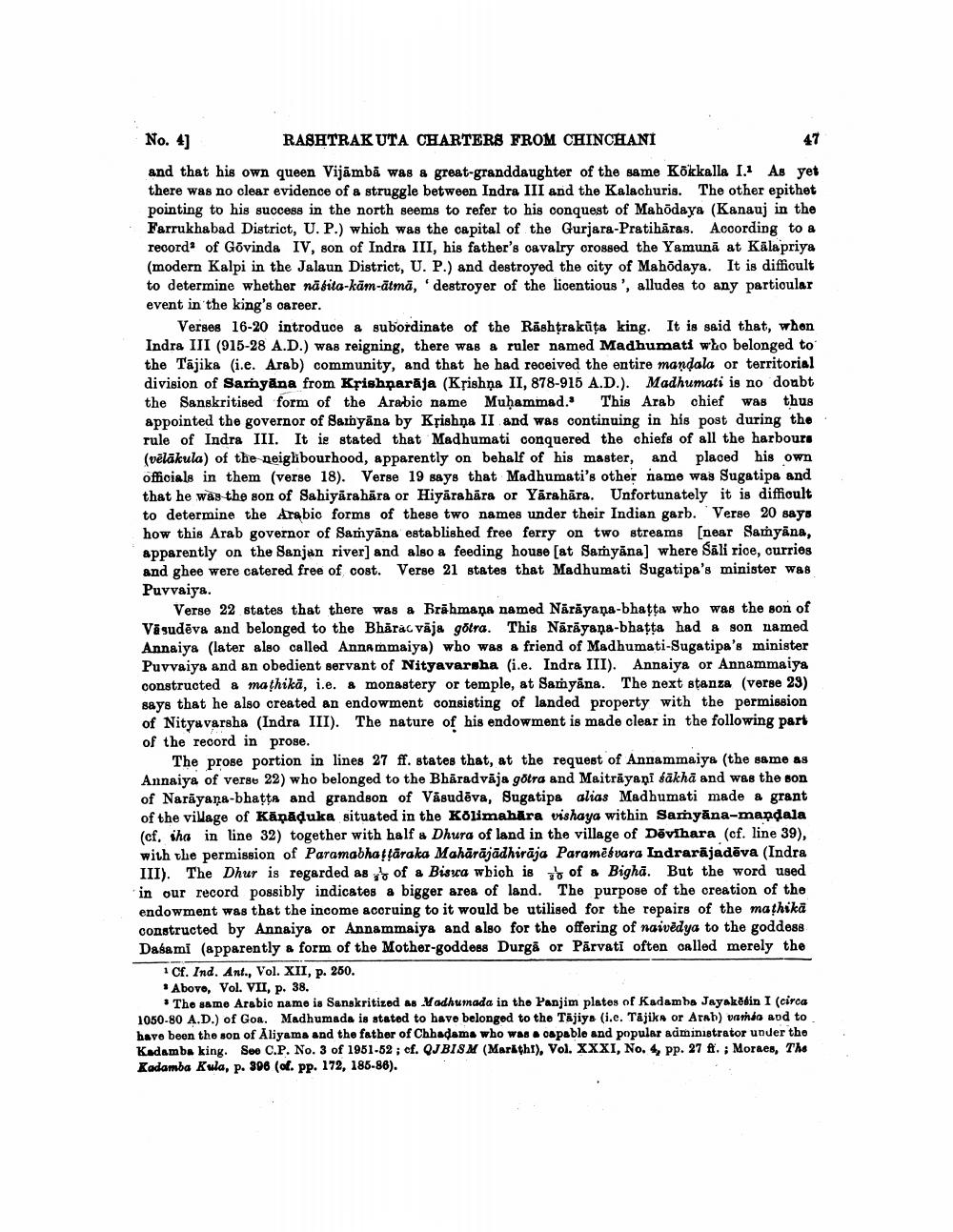________________
No. 4)
RASHTRAK UTA CHARTERS FROM CHINCHANI
and that his own queen Vijāmba was a great-granddaughter of the same Kõkkalla 1.1 As yet there was no clear evidence of a struggle between Indra III and the Kalachuris. The other epithet pointing to his success in the north seems to refer to his conquest of Mahödaya (Kanaun in the Farrukhabad District, U. P.) which was the capital of the Gurjara-Pratibāras. According to a record of Govinda IV, son of Indra III, his father's cavalry crossed the Yamunā at Kalapriya (modern Kalpi in the Jalaun District, U. P.) and destroyed the city of Mahodaya. It is difficult to determine whether nāfita-kām-ātmā, destroyer of the licentious', alludes to any partioular event in the king's career.
Verses 16-20 introduce a subordinate of the Rashtra küta king. It is said that, whon Indra III (915-28 A.D.) was reigning, there was a ruler named Madhumati who belonged to the Tājika (i.e. Arab) community, and that he had received the entire mandala or territorial division of Samyāna from Krishparāja (Krishna II, 878-915 A.D.). Madhumati is no doubt the Sanskritised form of the Arabic name Muhammad." This Arab chief was thus appointed the governor of Samyana by Krishna II and was continuing in his post during the rule of Indra III. It ie stated that Madhumati conquered the chiefs of all the harbours (vēlākula) of the neiglibourhood, apparently on behalf of his master, and placed his own officials in them (verse 18). Verse 19 says that Madhumati's other name was Sugatipa and that he was the son of Sahiyåra hära or Hiyarahāra or Yärahāra. Unfortunately it is difficult to determine the Arabic forms of these two names under their Indian garb. Verse 20 says how this Arab governor of Samyina established free ferry on two streams (near Samyana, apparently on the Sanjan river] and also a feeding house [at Samyana) where Sāli rice, curries and ghee were catered free of cost. Verse 21 states that Madhumati Sugatipa's minister was Puvvaiya.
Verse 22 states that there was a Brāhmaṇa named Närāyana-bhatta who was the son of Va gudēva and belonged to the Bhärad väja gotra. This Näräyana-bhatta had a son named Annaiya (later also called Annammaiya) who was a friend of Madhumati-Sugatipa's minister Puvvaiya and an obedient servant of Nityavarsha (i.e. Indra III). Annaiya or Annammaiya constructed & mathikā, i.e. & monastery or temple, at Samyana. The next stanza (verse 23) says that he also created an endowment consisting of landed property with the permission of Nityavarsha (Indra III). The nature of his endowment is made clear in the following part of the record in prose.
The prose portion in lines 27 ff. states that, at the request of Annammaiya (the same as Annaiya of verse 22) who belonged to the Bhāradvāja götra and Maitrāyani sākha and was the son of Narayana-bhatta and grandson of Vasudēva, Sugatips alias Madhumati made & grant of the village of Kāņāduka situated in the Kolimahāra vishaya within Samyāna-mandala (cf. iha in line 32) together with half a Dhura of land in the village of Dövihara (cf. line 39). with the permission of Paramabhaffāraka Mahārājādhirāja Paramēsvara Indrarājadēva (Indra III). The Dhur is regarded as yo of a Bisya wbich is of a Bigha. But the word used in our record possibly indicates a bigger area of land. The purpose of the creation of the endowment was that the income acoruing to it would be utilised for the repairs of the mathika constructed by Annaiya or Annammaiys and also for the offering of naivedya to the goddess Dasami (apparently a form of the Mother-goddess Durgā or Pārvati often called merely the
1 Cf. Ind. Ant., Vol. XII, p. 250. * Abovo, Vol. VII, p. 38.
• The same Arabic name is Sanskritized as Madhumada in the Panjim platos of Kadamba Jayakedin I (circa 1050-80 A.D.) of Goa. Madhumada is stated to have belonged to the Tajiya (i.e. Täjiks or Arab) vardo add to have been the son of Aliyama and the father of Chhadama who was capable and popular administrator under the Kadamba king. See C.P. No. 3 of 1981-52; cf. QJ BISM (Markthi), Vol. XXXI, No. 4, pp. 27 fl.; Moraes, The Kadamba Kula, p. 396 (ol. pp. 172, 186-86).




